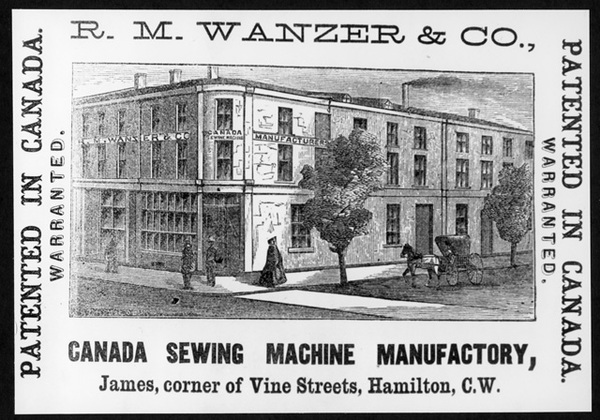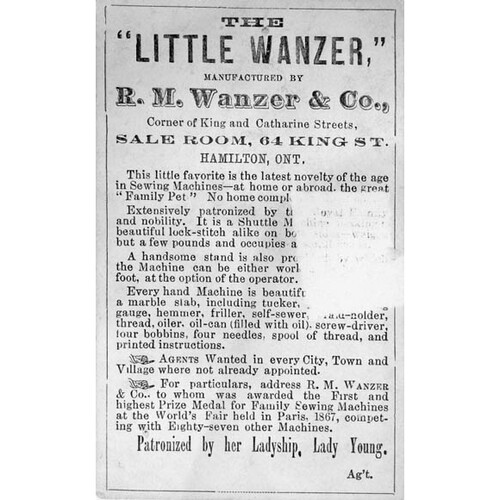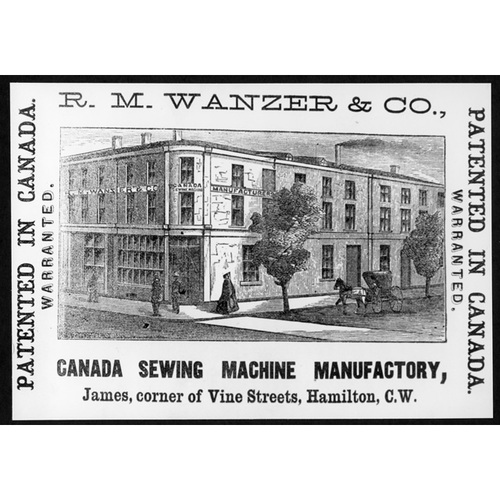
Source: Link
WANZER, RICHARD MOTT, manufacturer; b. probably 3 Sept. 1818 in New York State; m. Electa Ann Lyon, and they had a daughter and a son; d. 23 March 1900 in New York City and was buried in Hamilton, Ont.
Richard Mott Wanzer came from a Quaker family and apparently worked as a teacher, store clerk, and book agent. He was engaged in the book-publishing business in Buffalo, N.Y., and may have had some involvement in the American sewing-machine industry. After having encountered severe financial difficulties, he moved about 1859 to Hamilton to establish a sewing-machine manufactory. The first mechanical aid to be mass-produced for domestic use, the sewing-machine promised opportunity and wealth to those who could claim a share of the market. After the first successful machine had been patented in 1846 by Elias Howe, hundreds of factories were established in the United States, Canada, and the British Isles. With easy access to transportation routes and large labour forces, Hamilton and Guelph became the major manufacturing centres in Upper Canada.
Wanzer rented a stone building in Hamilton, where in 1860, with the backing of the iron-founding firm of Edward Gurney*, he began to manufacture the first sewing-machines made in Canada. He soon went into partnership with John Neil Tarbox, forming R. M. Wanzer and Company, which initially produced machines designed by the Wheeler and Wilson and the Singer companies in the United States. Prior to the Patent Act of 1872 in Canada, manufacturers were free to copy American patents or to incorporate patented features into their own machines. They were also independent of the Sewing Machine Combination, a powerful American trust that required all manufacturers using any of its patents to be licensed.
In 1862, claiming exclusive right to its manufacture, Wanzer advertised the “Family Shuttle Sewing Machine,” a Canadian-manufactured machine that combined the best features of the Wheeler and Wilson and the Singer machines. Originally patented by Christopher Lockman, a Hamilton machinist whose connection with Wanzer is unclear, the “Family Shuttle” machine “dispensed with the hook, brush-holder, clamp, bobbins, and all the little springs that so puzzle and perplex the operator,” replacing them with the Singer shuttle. At the time Wanzer employed 50 mechanics. By 1864 the number had risen to 70 and the company boasted an output of 60 machines a week. In 1868 Wanzer introduced a second model, the “Little Wanzer.” Its compact size, simplicity, and low price ($25 in 1870 or $30 on a stand) made it an instant favourite, and more than 4,000 were sold in the first year alone. Widely advertised and exhibited, Wanzer’s line had expanded to include four additional models by 1874.
Increasing production in the 1860s had prompted Wanzer to erect a new, four-storey factory. An energetic and enterprising businessman, he had added a large wing to the factory by December 1870, equipping it to produce 1,000 machines a week. Until September 1872 it was under the capable management of J. N. Tarbox, Wanzer’s partner, who had played a vital role that year in defeating the “nine hour” movement at the Wanzer plant [see James A. Ryan]. When employees demanded a nine-hour day, he locked them out, posting a notice that no more work was available. By the second week of June, however, the plant was running full-time. In 1875 Wanzer apparently bought out Tarbox and three years later he erected a more modern factory at an estimated cost of $300,000. In 1884 he added an extension to it.
Although Wanzer’s efforts were initially directed towards the Canadian market, he soon branched out into exports. He spent much of his time in London, England, where an office was organized to handle the foreign trade for the popular “Little Wanzer,” which cost much less than American machines. Branch offices and warehouses were subsequently established throughout Europe, and in Australia, South Africa, Turkey, Egypt, and Brazil. Parts were manufactured in Hamilton and then shipped to England for assembly. In addition, export rights for Wanzer machines were acquired by Hamilton businessman Isaac Buchanan*, whose son tried without success to sell them in Japan. Wanzer received gold medals for his machines at numerous international exhibitions. At the exposition in Vienna, in 1873, he not only received an award but was made a knight of the Order of Francis Joseph.
One of the province’s leading industries, R. M. Wanzer and Company increased its output to 1,500 machines a week between 1861 and 1881, during which period it produced about one and a half million machines. However, increased competition from American manufacturers, poor tariff protection, overproduction, and a sharp drop in demand during the depression of the 1880s severely damaged the company. In an attempt to raise funds to bolster his manufactory, Wanzer patented a lamp and cooking apparatus and in 1885 purchased a franchise to provide electric light in Hamilton, but in 1890 the largest and most successful of Ontario’s sewing-machine manufacturers went out of business. None of Wanzer’s subsequent ventures – the lamp company, a soap factory, or the Oneida Lamp Company in Niagara Falls – proved successful.
In 1898 a financially ruined Wanzer left Hamilton for Buffalo, planning to open the Wanzer Lamp and Cooker Company there. He died of pneumonia in New York City on 23 March 1900. His body lay in state at Hamilton City Hall and he was buried in Hamilton Cemetery. In reviewing his career and achievements, the Hamilton Spectator described him as the “personification of a perfect gentleman, a large hearted citizen and a most generous employer.”
AO, RG 55, partnership records, Wentworth County, declarations, no.69. HPL, Arch. file, Brown-Hendrie papers; City council, minutes, 1866–85 (mfm.); Clipping file, R. M. Wanzer; R. M. Wanzer & Co.; Wanzer Sewing Machine Co.; Wanzer Soap Co. Hamilton Herald (Hamilton, Ont.), 15 Nov. 1890. Hamilton Spectator, 6 Feb. 1861; 4 July 1867; 26 Nov. 1869; 3 Sept., 22 Dec. 1870; 1 May 1871; 11, 24 Sept. 1872; 21 Aug. 1883; 13 Feb. 1884; 20 Sept. 1890; 3 Aug. 1892; 24, 27 March 1900. Times (Hamilton), 26 Nov., 18 Dec. 1868; 7 June 1898; 27 March 1900. DHB. Wentworth County directory, 1865–66. M. J. Eckmann Brent, “A study of the sewing machine industry of Ontario, 1860–1897, including a handbook for museum workers” (m.museology thesis, Univ. of Toronto, 1979). [J. J.] B. Forster, A conjunction of interests: business, politics, and tariffs, 1825–1879 (Toronto, 1986). Douglas McCalla, The Upper Canada trade, 1834–1872: a study of the Buchanans’ business (Toronto, 1979). B. D. Palmer, A culture in conflict: skilled workers and industrial capitalism in Hamilton, Ontario, 1860–1914 (Montreal, 1979). M. [J.] Eckmann Brent, “A stitch in time: the sewing machine industry of Ontario, 1860–1897,” Material Hist. Bull. (Ottawa), 10 (1980): 1–30. Hamilton Spectator, 19 Dec. 1914; 20, 27 Sept., 4 Oct. 1941.
Cite This Article
Nancy Kiefer, “WANZER, RICHARD MOTT,” in Dictionary of Canadian Biography, vol. 12, University of Toronto/Université Laval, 2003–, accessed December 29, 2025, https://www.biographi.ca/en/bio/wanzer_richard_mott_12E.html.
The citation above shows the format for footnotes and endnotes according to the Chicago manual of style (16th edition). Information to be used in other citation formats:
| Permalink: | https://www.biographi.ca/en/bio/wanzer_richard_mott_12E.html |
| Author of Article: | Nancy Kiefer |
| Title of Article: | WANZER, RICHARD MOTT |
| Publication Name: | Dictionary of Canadian Biography, vol. 12 |
| Publisher: | University of Toronto/Université Laval |
| Year of publication: | 1990 |
| Year of revision: | 1990 |
| Access Date: | December 29, 2025 |




